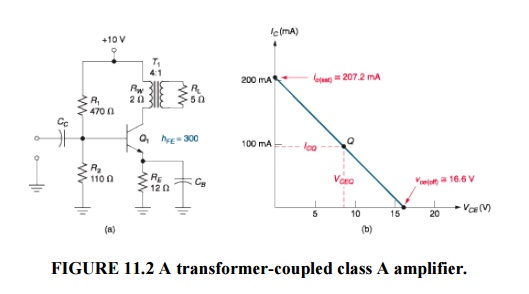Chapter: Electronic Devices and Circuits : Multistage Amplifiers and Differential Amplifier
Power Amplifiers
POWER AMPLIFIERS :
The ideal amplifier would deliver 100 percent of the power it draws from the dc power supply to its load. In practice, 100 percent efficiency cannot be achieved (at this time) because every amplifier uses some percentage of the power it draws from the dc power supply.
The efficiency of an amplifier is the ratio of ac output power to dc input power, written as a percentage. By formula:

The lower the position of the Q-point on the dc load line, the higher the maximum theoretical efficiency of a given amplifier. Typical Q-point locations for class A, B, AB, and C amplifiers are shown in Figure 11.1 of the text.
AC Load Lines
The ac load line is a graph of all possible combinations of ic and vce for a given amplifier. Under normal circumstances, the ac and dc load lines for a given amplifier are not identical (see Figure 11.3 of the text).
Amplifier Compliance
The compliance (PP) of an amplifier is the limit that the output circuit places on its peak-to-peak output voltage. The compliance for a given amplifier is found using the following equations:
PP = 2lCQrC and PP = 2VCEQ
These equations are developed as illustrated in Figure 11.1.

The compliance of an amplifier is determined by solving both PP equations and using the lower of the two results, as demonstrated in Example 11.1 of the text. Note the following:
· When an amplifier has a value of PP = 2VCEQ, exceeding the value of PP results in saturation clipping.
· When an amplifier has a value of PP = 2lCQrC, exceeding the value of PP results in cutoff clipping. However, the circuit will experience nonlinear distortion before the amplifier peak-to-peak output reaches the value of PP.
1. Transformer-Coupled Class A Amplifiers
A transformer-coupled class A amplifier is shown in Figure 11.2. The transformer is used to couple the amplifier output signal to its load.

The dc biasing of the transformer-coupled class A amplifier is similar to that of other amplifiers, outside of the fact that the value of VCEQ is designed to be as close as possible to the value of VCC.
Plotting the ac load line of a transformer-coupled class A amplifier is demonstrated in Section 11.3.3 of the text. The following are typical characteristics for the transformer-coupled circuit:
· VCEQ is very close to the value of VCC.
· The maximum output voltage is very close to 2VCEQ and therefore, can approach the value of 2VCC.
The maximum theoretical efficiency of a transformer-coupled class A amplifier is 50%.
In practice, the transformer-coupled amplifier has a value of
The transformer-coupled class A amplifier has the following advantages over the RC-coupled circuit:
· Higher efficiency.
· It is relatively simple to match the amplifier and load impedance using a transformer.
· A transformer-coupled circuit can easily be converted to a tuned amplifier; that is, a circuit that provides a specific value of gain over a specified range of operating frequencies.
2. Class B Amplifiers
The class B amplifier is a two-transistor circuit that is designed to improve on the efficiency characteristics of class A amplifiers. A class B amplifier is shown in Figure 11.3. The Q-point values for the circuit in Figure 11.3 are found using

where ICO is the collector cutoff current rating for the transistor.

The circuit shown in Figure 11.3 is a complementary-symmetry amplifier, or a push-pull emitter follower. The circuit contains one npn transistor (Q1) and one pnp transistor (Q2). The circuit contains complementary transistors; that is, npn and pnp transistors with identical characteristics
3. Class C Amplifiers
Class C amplifiers were briefly mentioned in Chapter 11. The transistor in a class C amplifier conducts for less than 180° of the input cycle. A basic class C amplifier is illustrated in Figure 17.14.

The most important aspect of the dc operation of this amplifier is that it is biased deeply into cutoff, meaning that VCEQ =~~=VCC and ICQ =~~= 0 A. If a negative supply is used to bias the base circuit, the value of VBB usually fulfills the following relationship:
–VBB = 1 V – Vin(pk)
The ac operation of the class C amplifier is based on the characteristics of the parallel-resonant tank circuit. If a single current pulse is applied to the tank circuit, the result is a decaying sinusoidal waveform (as shown in Figure 17.43b of the text). The waveform shown is a result of the charge/discharge cycle of the capacitor and inductor in the tank circuit, and is commonly referred to as the flywheel effect.
To produce a sine wave that does not decay, we must repeatedly apply a current pulse during each full cycle. At the peak of each positive alternation of the input signal, the tank circuit in a class C amplifier gets the current pulse it needs to produce a complete sine wave at the output. This concept is illustrated in Figure 17.44 of the text. Note that T1, T2, and T3 are inverted at the output relative to the input. This is due to the fact that a common-emitter amplifier produces a 180° voltage phase shift. Note that the bandwidth, Q, and QL characteristics of a class C amplifier are the same as those for any tuned discrete amplifier.
One final point about the class C amplifier. In order for this amplifier to work properly, the tank circuit must be tuned to the same frequency as the input signal, or to some harmonic of that frequency. For instance, you could tune the class C amplifier to the third harmonic of the input and have an output that is three times the input frequency. As such, the class C amplifier can be used as a frequency multiplier.
Related Topics